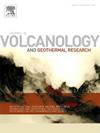Evolution of the crustal reservoir feeding La Palma 2021 eruption. Insights from phase equilibrium experiments and petrologically derived time scales
IF 2.3
3区 地球科学
Q2 GEOSCIENCES, MULTIDISCIPLINARY
Journal of Volcanology and Geothermal Research
Pub Date : 2025-04-11
DOI:10.1016/j.jvolgeores.2025.108327
引用次数: 0
Abstract
Crystallization experiments were performed on three representative samples of the 2021 La Palma eruption at variable temperatures (920–1150 °C), pressures (100–400 MPa), and H2O-CO2 ratios in order to shed light on the pre-eruptive reservoir architecture and evolution. Experimental data reveal that La Palma crustal reservoir was at 300 MPa (10 km), at a temperature of 1065 °C with a melt water content of 2–3 wt%, lying in the stability field of amphibole. Mineral compositional zoning along with experimental constraints and whole rock data, show that a cold magma body (850–950 °C), likely a remnant of previous eruptive episodes at La Palma, was rejuvenated by hotter magmas that increased the temperature of the bottom portion of the reservoir up to 1135 °C. Time scales derived from olivine diffusion profiles show that such a reactivation started 10–15 years prior to eruption, and was marked by at least four different injections from a deep mantle reservoir at ≥25 km. This sequence is corroborated by geophysical signals and changes of surficial fluid geochemistry monitored during that period. Olivine zoning further indicates that the last mafic recharge prior to eruption onset occurred in mid-October 2018, and was followed by a post-injection cooling phase which continued up to the date of the eruption, during which the top portion of the rejuvenated body re-entered the stability field of amphibole. This cooling period preceding the eruption could in part explain the absence of pre-eruptive seismic signals at ∼10 km, as revealed by the revision of the precursory seismic catalogue since 2017. Once initiated, the eruption drained the 300 MPa body, which in turn activated the deep-seated mantle reservoir, lying at >500–600 MPa, which supplied fresh, hotter and volatile-rich magma, that was emitted during the second half of the eruptive episode. Amphibole breakdown documented in first emitted magmas is related to decompression and not to overheating of the resident magmas. The fact that the rocks emitted during the first half of the eruption do not bear textural or compositional evidence for a mafic recharge occurring a short time prior the eruption suggest that the eruption triggering is linked to the internal evolution of the reservoir (volatile build-up) or to external factors.
拉帕尔马火山2021年喷发的地壳储层演化。从相平衡实验和岩石学衍生的时间尺度的见解
在温度(920 ~ 1150°C)、压力(100 ~ 400 MPa)和H2O-CO2比不同的条件下,对2021年拉帕尔马火山喷发的3个代表性样品进行了结晶实验,以揭示喷发前储层的结构和演化。实验数据表明,拉帕尔马地壳储层位于角闪孔稳定场,储层强度为300 MPa (10 km),温度为1065℃,熔体水含量为2 ~ 3% wt%。矿物成分分区以及实验约束和整个岩石数据表明,一个冷岩浆体(850-950°C),可能是拉帕尔马以前爆发事件的残余,被更热的岩浆恢复活力,将储层底部的温度提高到1135°C。橄榄石扩散剖面的时间尺度表明,这种重新激活始于喷发前10-15年,标志着至少4次不同的注入,这些注入来自≥25 km的深部地幔储层。地球物理信号和该时期监测的地表流体地球化学变化证实了这一序列。橄榄石分带进一步表明,火山爆发前的最后一次镁铁质补给发生在2018年10月中旬,随后是注入后的冷却阶段,一直持续到喷发日期,在此期间,恢复活力的体的顶部重新进入角闪孔稳定场。正如自2017年以来对前兆地震目录的修订所揭示的那样,火山爆发前的冷却期可以部分解释火山爆发前10公里处没有地震信号的原因。一旦喷发开始,300兆帕的岩浆就会被抽干,这反过来又激活了位于500-600兆帕的深部地幔储层,这些储层提供了新鲜的、更热的、富含挥发物的岩浆,这些岩浆在喷发的后半段被释放出来。在第一次喷发的岩浆中记录的角闪孔破裂与减压有关,而不是与常驻岩浆的过热有关。事实上,在火山喷发的前半段喷出的岩石并没有在喷发前短时间内发生的基性补给的结构或成分证据,这表明火山喷发的触发与储层的内部演化(挥发性积聚)或外部因素有关。
本文章由计算机程序翻译,如有差异,请以英文原文为准。
求助全文
约1分钟内获得全文
求助全文
来源期刊
CiteScore
5.90
自引率
13.80%
发文量
183
审稿时长
19.7 weeks
期刊介绍:
An international research journal with focus on volcanic and geothermal processes and their impact on the environment and society.
Submission of papers covering the following aspects of volcanology and geothermal research are encouraged:
(1) Geological aspects of volcanic systems: volcano stratigraphy, structure and tectonic influence; eruptive history; evolution of volcanic landforms; eruption style and progress; dispersal patterns of lava and ash; analysis of real-time eruption observations.
(2) Geochemical and petrological aspects of volcanic rocks: magma genesis and evolution; crystallization; volatile compositions, solubility, and degassing; volcanic petrography and textural analysis.
(3) Hydrology, geochemistry and measurement of volcanic and hydrothermal fluids: volcanic gas emissions; fumaroles and springs; crater lakes; hydrothermal mineralization.
(4) Geophysical aspects of volcanic systems: physical properties of volcanic rocks and magmas; heat flow studies; volcano seismology, geodesy and remote sensing.
(5) Computational modeling and experimental simulation of magmatic and hydrothermal processes: eruption dynamics; magma transport and storage; plume dynamics and ash dispersal; lava flow dynamics; hydrothermal fluid flow; thermodynamics of aqueous fluids and melts.
(6) Volcano hazard and risk research: hazard zonation methodology, development of forecasting tools; assessment techniques for vulnerability and impact.

 求助内容:
求助内容: 应助结果提醒方式:
应助结果提醒方式:


